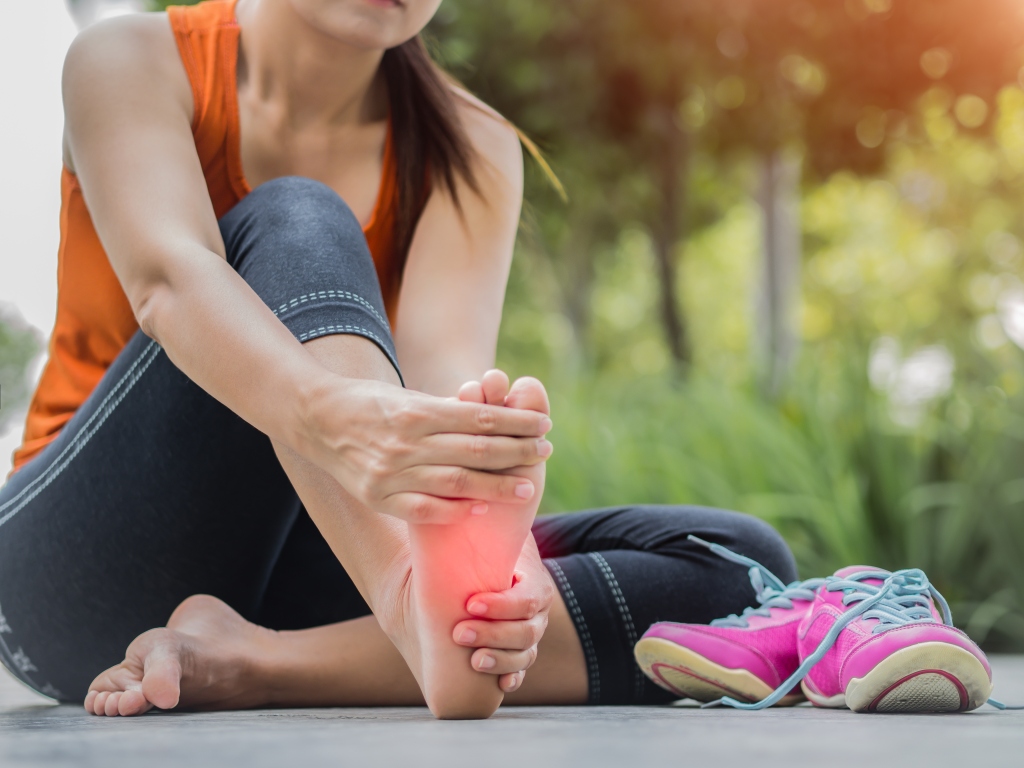
Plantar Fasciitis is one of the most common running injuries1 and many runners use shoes that worsen symptoms. There are several misconceptions surrounding proper footwear for plantar fasciitis. Examples of false beliefs among runners include preferences for shoes with high cushion, minimal support and zero heel drop. New research points towards correlating anatomical and biomechanical makeup with specific footwear components. Here’s what to consider when recommending running shoes for runners with plantar fasciitis.
Why Does Plantar Fasciitis Worsen With Running?
Plantar fasciitis is caused by micro-tears of the plantar fascia developing from repetitive overstretching. While causation can be multifactorial, risk factors to plantar fasciitis include pes cavus, pes planus, reduced functional muscle length of the gastrocnemius/soleus and limited ankle range of motion2. Some patients will present with heel spurs but rarely are they the cause for plantar fasciitis. While running, often plantar fasciitis symptoms worsen due to the high impact forces runners sustain at the initial contact phase of gait and tension placed on the plantar fascia during terminal stance/toe off3. During initial impact the stress placed through the plantar fascia can be aggravated from the arch can collapse due to the impact of the ground reaction forces or pressure from either footwear or biomechanical changes such as forefoot external rotation, reduced dorsiflexion ROM and limited gastrocnemius/soleus mobility.
How Can Running Shoes HURT Plantar Fasciitis?
Many athletes look for supportive shoes with high arch support. Conversely, other runners look for minimally supportive shoes with little support. Other common footwear selections include shoes with high cushion, zero drop and rocker soles. Unfortunately many of these footwear options can worsen symptoms for runners with plantar fasciitis. One example is runners with low arches should avoid high arch support shoes due to increased pressure on the plantar fascia. Another example is soft, high cushion soles cause more impact and stress on the foot/lower extremities3 which correlates to increased plantar fascia pain. Lastly, minimal shoes do not support the arch of the foot and allow the arch to collapse in many runners, aggravating plantar fasciitis.
How Can Running Shoes HELP Plantar Fasciitis?
Finding the right pair of shoes for runners is essential in improving their plantar fasciitis. While some clinicians rarely change running footwear, running experts agree several features of running footwear are important to help patients with plantar fasciitis. Emerging evidence shows that a stiff midsole3 decreases the stress put on the plantar fascia while running. In recent years experts agree that moderate cushion shoes reduce ground reaction forces and impact on the lower extremities compared to high cushion shoes3. Additionally, excessive arch support for patients with low to moderate arches increases external pressure and thus worsens symptoms of plantar fasciitis. Therefore, it’s recommended for runners with plantar fasciitis to consider shoes with high midsole rigidity, moderate cushion and arch support that corresponds with their arch shape.
What Should Runners With Plantar Fasciitis Look For In A Running Shoe?
Running experts agree, selecting the right running shoe starts with integrating a runner’s anatomical makeup and running gait biomechanics into their footwear decisions2. Several key factors on a running gait analysis should be considered including foot strike, foot progression angle (forefoot internal or external rotation), presences of arch collapse, genu valgum and hip drop. Most importantly footwear should be selected depending on arch support, midsole rigidity, sole cushion and heel cup support.
If you’ve tried new shoes and your symptoms have not improved within 2 weeks give us a call at (510) 644-8031 and ask for a free virtual physical therapy consult today.
Justin Jellin, DPT
Program Director RUNATOMY
Edited by: Daniela Norwood, PT, DPT, MS
REFERENCES
- Zhu X, Liu J, Liu H, Liu J, Yang Y, Wang H. Effects of Midsole Hardness on the Mechanical Response Characteristics of the Plantar Fascia during Running. Bioengineering. 2023; 10(5):533. https://doi.org/10.3390/bioengineering10050533
- Buchanan BK, Kushner D. Plantar Fasciitis. [Updated 2022 May 30]. In: StatPearls [Internet]. Treasure Island (FL): StatPearls Publishing; 2023 Jan-. Available from: https://www.ncbi.nlm.nih.gov/books/NBK431073/
- Laurent Malisoux, Paul Gette, Anne Backes, Nicolas Delattre & Daniel Theisen (2023) Lower impact forces but greater burden for the musculoskeletal system in running shoes with greater cushioning stiffness, European Journal of Sport Science, 23:2, 210-220, DOI: 10.1080/17461391.2021.2023655